Feature
Better Together
How One Nonprofit Combined Established Teaching Strategies in New Ways for a Transformative Approach to STEM Education
Connected Science Learning April-June 2019 (Volume 1, Issue 10)
By Lizzie Murchison and Emma Banay
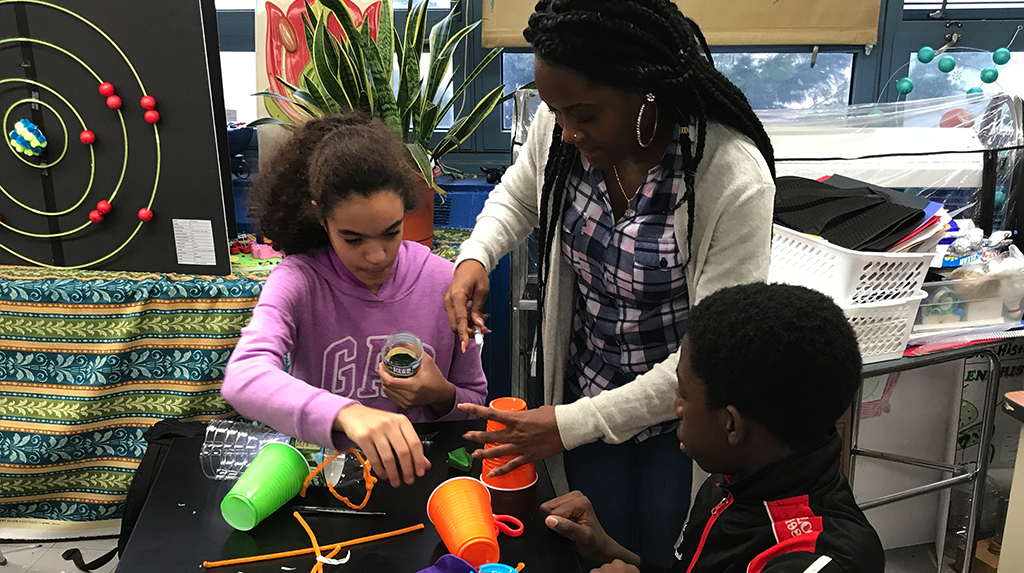
When ExpandED Schools, a nonprofit based in New York, began planning a new STEM (science, technology, engineering, and math) initiative three years ago, it started by taking a closer look at the existing science programming happening in its network of afterschool programs. As an intermediary, ExpandED supports out-of-school-time (OST) programs by serving as a connection-maker and coordinator among community-based organizations, schools, funders, staff, and government players. It provides professional development and coaching to afterschool providers and works with stakeholders throughout the informal education landscape to identify and address the needs of the field as a whole. In 2015 ExpandED saw that one of those needs was a more strategic approach to science education in afterschool.
Over half of eighth-grade students in New York City were failing to pass state science exams. Despite this clear need, ExpandED saw that many of the science activities taking place within its OST network were only peripherally related to actual science practices. In some programs, gardening and cooking classes had been broadly labeled “STEM enrichment activities” without any clear connection to science concepts. In others, students drudged through math worksheets or standardized test preparation lessons with little distinction from school-day instruction. A few clubs offered access to engaging technology such as Lego Robotics, stop-motion cameras, and video-editing software. However, the programs team at ExpandED Schools noticed that these tech clubs typically provided few connections to what was being taught during students’ school math and science classes. None of the programs were effective in both developing interest in science and helping students build the skills they needed to succeed academically. ExpandED believed that afterschool could turn that trend around by providing an ideal setting to increase students’ interest and achievement in science.
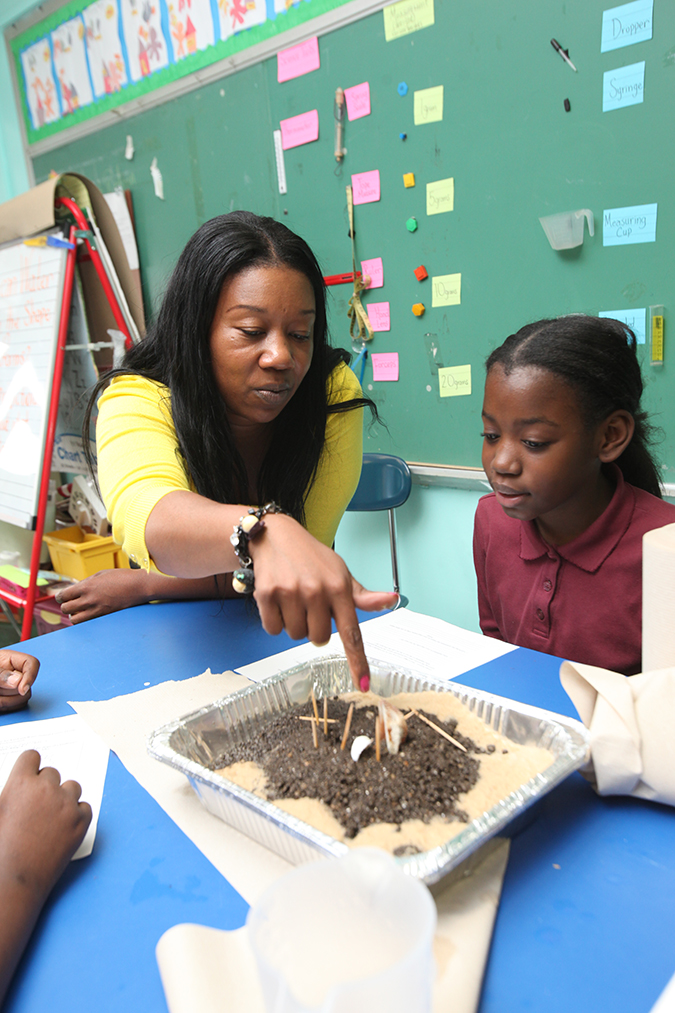
With this goal in mind, experts from ExpandED partnered with the New York Hall of Science (NYSCI), a local STEM-rich institution, to develop a program that would bring together elements supported by strong bodies of research to both captivate students’ imaginations and help them make critical links between their own life experiences and the science all around them. ExpandED hypothesized that layering three proven strategies—collaborative teaching, curricular bridging, and design-based learning—could produce a compounding effect that was greater than the sum of its parts.
To ensure their program was engaging for youth, ExpandED and NYSCI decided to introduce real science and engineering problems through the lens of fun, design-based competitions, such as building and racing “chem cars” to explore Newton’s laws or engineering a prosthetic bird beak to learn about animal adaptations. After an extensive application process and two rounds of recruitment, the program was implemented at 15 middle schools (grades 6–8), all serving youth through New York City’s publicly funded afterschool model, offered by 12 unique community-based organizations (the OST providers).
In response to concerns from these schools and community-based organizations about afterschool facilitators teaching content that was out of step with the school day, ExpandED and NYSCI were careful to create a program that could act as a “curricular bridge” between the content students were learning during the formal school day and their experiences in afterschool. Educators in the program ran activities that built on school-day science concepts and shared a common “STEM program vision” with the school.
To ensure this academic alignment was maintained, ExpandED arranged for weekly coplanning and coteaching sessions between afterschool educators and a certified STEM educator from each grade. By pairing afterschool educators, who had expertise in positive youth development practices, with certified teachers, who had a strong understanding of pedagogy, the organization hoped to elevate the teaching practice of both groups simultaneously.
Focusing on these three strategies, ExpandED launched the Design2Learn program in the fall of 2016 with funding from the U.S. Department of Education’s Investing in Innovation Fund, the Overdeck Family Foundation, and the Pinkerton Foundation. The Research Alliance for New York City Schools is currently evaluating the initiative’s impact through a randomized controlled trial at 31 afterschool sites. At each of the implementation sites, collaborative teams (made up of a certified science teacher from participating students’ grade band and two afterschool educators) participate in joint professional development at NYSCI and facilitate highly engaging, design-based STEM challenges for two hours each week in the afterschool program. Over the past two years, youth have designed arthropod-inspired appendages for a “bug battle,” engineered life-size plastic wrap mannequins to model systems of the body, created wingsuits for extreme sports–inspired gliders, and engineered packaging for an egg drop. In addition to facilitating lessons, educators meet for one hour of coplanning each week to prepare for activity facilitation and discuss key issues such as student engagement.
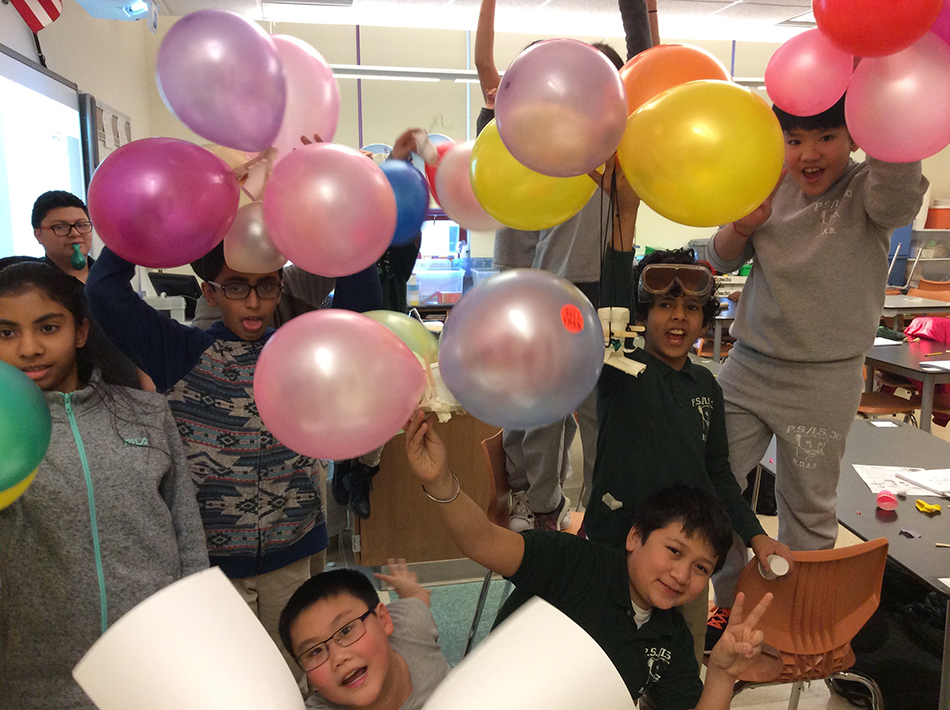
Collaborative teaching
The driving force behind the collaborative teaching strategy is the educator team. In Design2Learn, coteaching can take many forms, inspired by the “Six Co-Teaching Models” guide from Teaching Tolerance. In some cases, educators “team teach,” seamlessly cofacilitating instruction. In others, educators lead parallel stations or groups of youth (e.g., one educator works with some students on engineering a volcano-resistant structure, while another educator experiments with other students to find an appropriate chemical reaction to simulate a volcano eruption). Sometimes, educators lead groups of youth in an activity simultaneously. For example, educators at a bilingual school might deliver a design challenge prompt simultaneously in English and Spanish, and then designate mixed-language groups of youth to work on the challenge together.
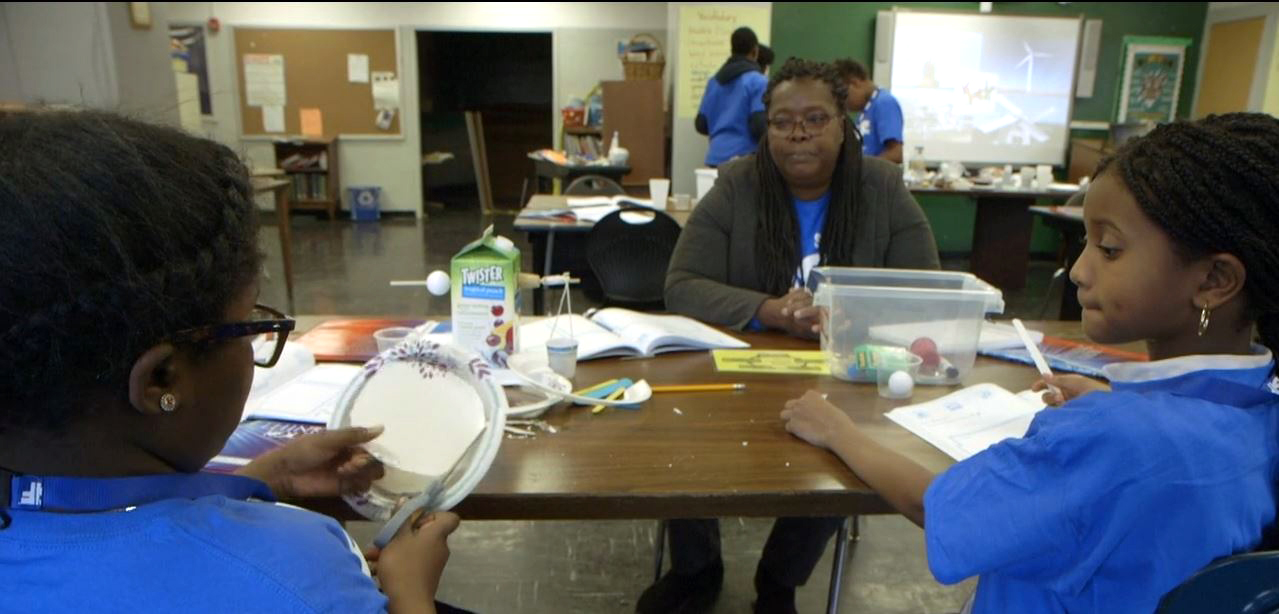
Photo credit: JR Sheetz
An example from The New School for Leadership and the Arts, a middle school in the Bronx, demonstrates how this collaborative approach can leverage the strengths of different educators. In spring 2018, the educator team at The New School met for a weekly coplanning session and the school-day teacher explained that her science classes were studying diffusion and osmosis. The team wanted to explore this content in afterschool in a fun way that wouldn’t be possible during the school day. After discussing different possibilities, they selected an “airzooka” design challenge. Youth would design a model miniature air cannon capable of knocking over a series of cups through the force of the air particles propelled out of the cannon (click here to try the airzooka design challenge in your classroom).
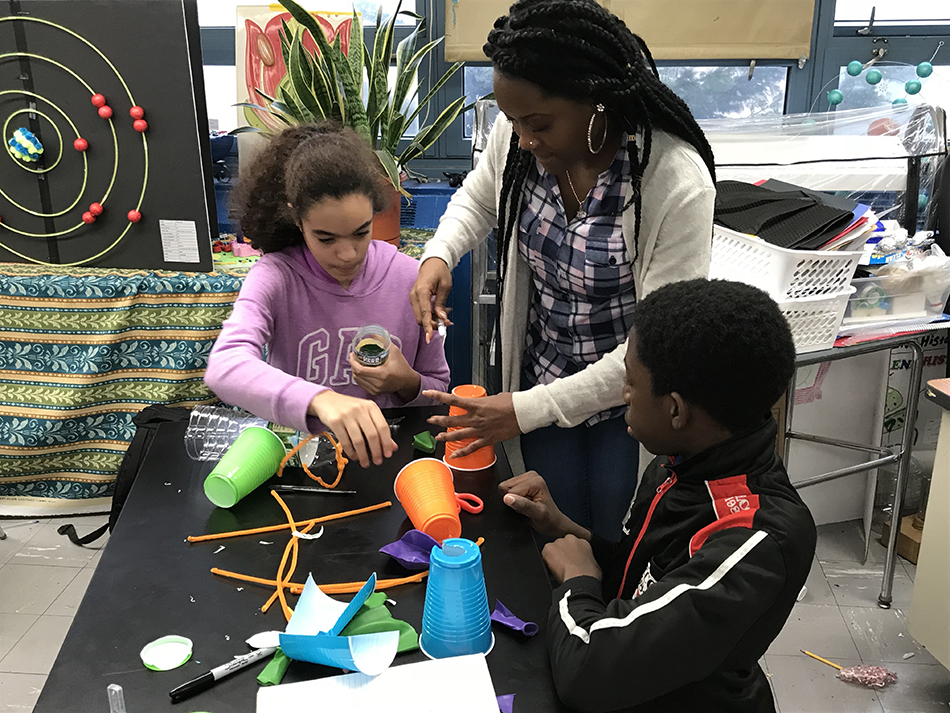
During coplanning for the activity, one of the afterschool educators expressed her concern that reading a definition for the term “diffusion” would feel too dry. To lighten things up, she suggested a movie clip from the film Grown Ups showing a swimmer peeing in a pool, demonstrating diffusion in a funny and relevant way. Youth loved the clip and listened intently as the school-day teacher introduced the challenge, referencing science concepts they had learned earlier that week in class. To increase the “fun factor” and help illustrate the movement of particles through the air, the afterschool educators brought in a fog machine to test the students’ cannon designs. Each of the educators contributed something important to the lesson plan (e.g., content knowledge of challenging science concepts from the school-day teacher, fun additions such as the movie clip and fog machine from the afterschool educator) to help students explore the concept of diffusion while still having a great time.
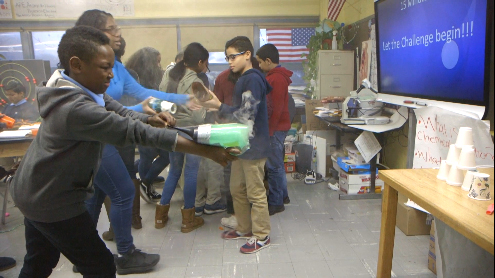
Photo credit: JR Sheetz
Much of the existing research on collaborative teaching focuses on models that bring together two or more certified teachers (typically a general education teacher and a special education teacher) during the school day (Friend and Cook 2010). When ExpandED began planning the Design2Learn project, it found comparatively little evidence of the value of bringing together school-day educators with afterschool educators. At first, funders questioned whether significant outcomes could be expected from a model that paired experienced STEM educators with afterschool facilitators who frequently had not yet completed their undergraduate degrees. However, previous experience with formal–informal educator collaborations made ExpandED optimistic about the coteaching model. In an early pilot of Design2Learn, both school-day and community educators reported an increase in hands-on learning and youth participation as a direct result of their collaboration. Interestingly, when asked to rank the next most significant impact of the program, the results differed by teaching role. School-day teachers reported that they improved in cultivating positive staff–student and student–student relationships as a result of their collaboration with afterschool educators. Afterschool educators, on the other hand, reported an improvement in their lesson planning and STEM content knowledge. Each group gained skills in the area in which the other group excelled.
Research indicates that coteaching provides more opportunities for teacher–student interaction, increases differentiated instruction, and serves as a predictor of student performance (Moorehead and Grillo 2013; Zito 2011). These benefits flow naturally from having an additional adult in the room, reducing staffing ratios and freeing the primary educator’s time to work individually or in small groups with students.
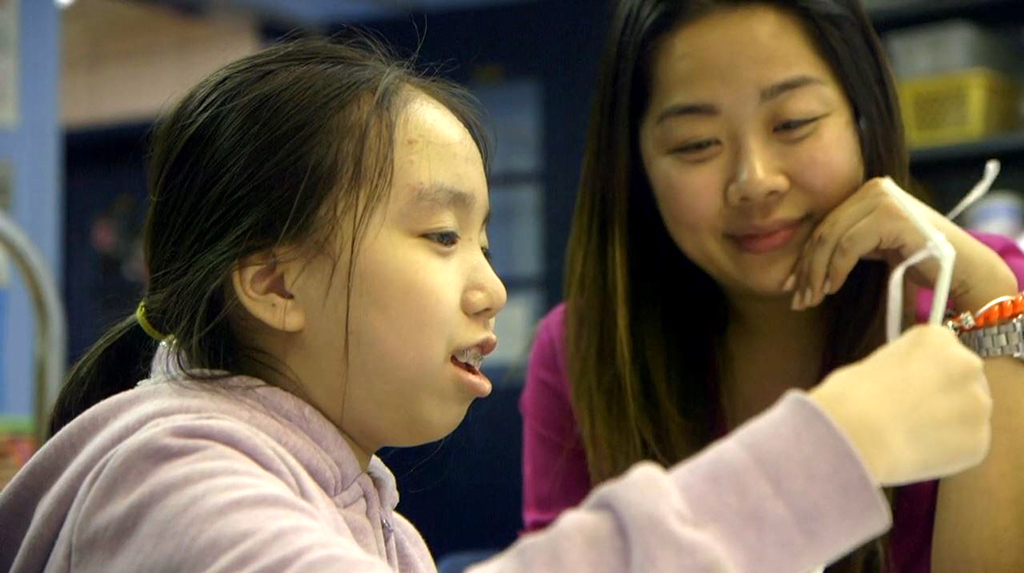
Photo credit: JR Sheetz
ExpandED believes these core benefits are strengthened when the coteaching happens across day school and afterschool. For their part, certified teachers bring content knowledge and pedagogical modeling to the equation. In the example from The New School for Leadership and the Arts, the science teacher selected the science concept and anticipated common student misconceptions (such as the challenge of understanding diffusion when it is not visible). Afterschool educators, on the other hand, contributed expertise in cultural competencies and youth development, keeping “what’s fun” central to the activity.
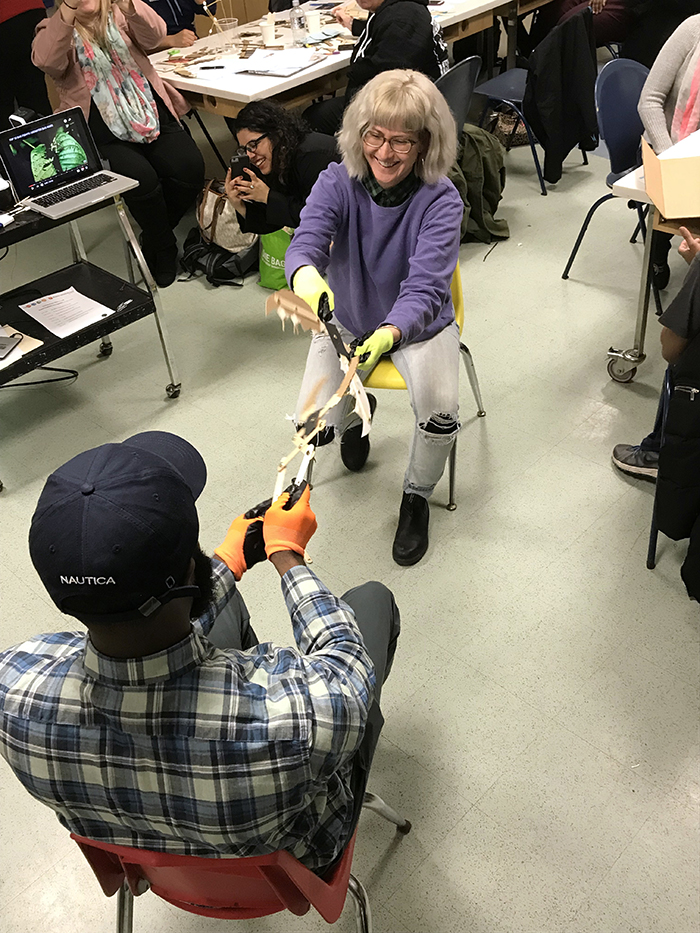
Design2Learn educators expressed enthusiasm for the collaborative teaching model, with 96% of educators agreeing that collaborating has improved program quality. However, the program has also surfaced some common challenges. One school-day teacher reflected, “There was definitely a learning curve for me: vacillating between the academic standards and just letting go and having fun. I know the standards and I think that mentality from during the day trickled over sometimes.” Below, program staff share the following tips to address the most common challenges.
- If the power dynamic between educators is uneven, build get-to-know-you time into training and professional development agendas. Design2Learn educators repeatedly reported that opportunities to work together, build trust, test design challenges as a team, share strengths and weaknesses, and connect as peers before working together professionally helped bolster their team’s ability to work together successfully. This time can help the two educator audiences view each other more respectfully, recognizing that they bring different expertise to the partnership.
- If finding time to meet is a challenge, consider flexible alternatives to coplanning requirements. Because school-day and afterschool programs typically operate on opposite schedules, many Design2Learn educator teams initially struggled to find a common hour for planning that did not interfere with their existing responsibilities. In response to this challenge, teams pursued a variety of alternatives to traditional roundtable planning sessions, such as coplanning remotely using tools such as Samepage, Google Docs, or video-conferencing; having afterschool educators join teachers during school-day prep periods; and conducting more planning hours at the beginning of the year in advance of busier periods.
- If compensation is a barrier, recognize that collaborative teaching and planning requires time and effort for educators beyond their normal scope of work. Consider how educators will be compensated for their time, how existing paid staff time can be used in a new way to support collaborative teaching, or what new funding sources might be tapped to support the time necessary for educators to work and teach together. For example, Design2Learn activities are incorporated into afterschool programs that are already funded by the New York City Department of Youth and Community Development. By recruiting afterschool educators whose instructional time was already budgeted, ExpandED Schools was able to target its funding toward the costs of the model not already assumed by participating sites: namely, educators’ professional development time and coplanning hours.
Curricular bridging
Whereas Design2Learn’s first core strategy emphasizes bringing together formal and informal educators to leverage their distinct skill sets, its second core strategy uses the same mechanism but takes aim at a slightly different goal: creating greater cohesiveness across students’ days through the intentional alignment of in-school and afterschool learning (Noam 2003). Existing research provides a strong basis for this strategy. According to Noam, Biancarosa, and Dechausay (2002), congruity of environments, learning goals, and teaching styles is associated with increased student performance. Noam also writes that the concept shows promise as a strategy for student engagement, as OST-time activities linked to academic curricular goals connect children’s “divergent worlds,” making learning “more meaningful and relevant to [students’] life experience” (Noam 2003). ExpandED reasons that students need more time to explore science content they encounter during the school day and that afterschool programs are able to provide a more relaxed setting to facilitate informal exploration, engagement, and play. As one Design2Learn educator summarized, “Kids have told us that what we do here [in afterschool] helps them better understand what they learn in school.” Curricular bridging may also boost the formal sector’s appreciation of OST-time partners, enhancing the reputation of afterschool programs as effective spaces to extend and enrich student learning, with direct benefits for school-day performance.
ExpandED leads Strategic Planning Retreats at each Design2Learn school to help create a “STEM vision” that guides the project. For example, at Highland Park Community School, the principal, afterschool site director, and Design2Learn educator team developed a vision for their program where “engagement, outreach, and leadership lead to real STEM application for kids. Through crosscutting concepts, [they] aim for seamless collaboration between the school and afterschool.” This shared vision had the buy-in of both informal and formal partners. Following the creation of the vision statement, the school-day teacher began inviting afterschool educators to participate in school-day classes, and she herself worked to recruit more of her school-day students to participate in the afterschool program.
Professional development providers play a necessary role in building and supporting curricular bridging. Joint professional development attended by informal and formal educators provides a shared training experience that gives educators a common philosophy and set of practices to employ in their afterschool programs. Joint professional development should explicitly call out strategies or approaches to teaching and learning that draw on the expertise of formal and informal actors. For example, Design2Learn’s Summer Institute includes “NGSS [Next Generation Science Standards] 101” sessions that familiarize informal educators with the state and national standards that formal educators use in the classroom, as well as provide training on facilitation skills such as linking activities to youth’s home lives and personal interests or creating opportunities for youth to make authentic design choices, skills that are more common hallmarks of informal learning settings. For a sample Summer Institute agenda, click here.
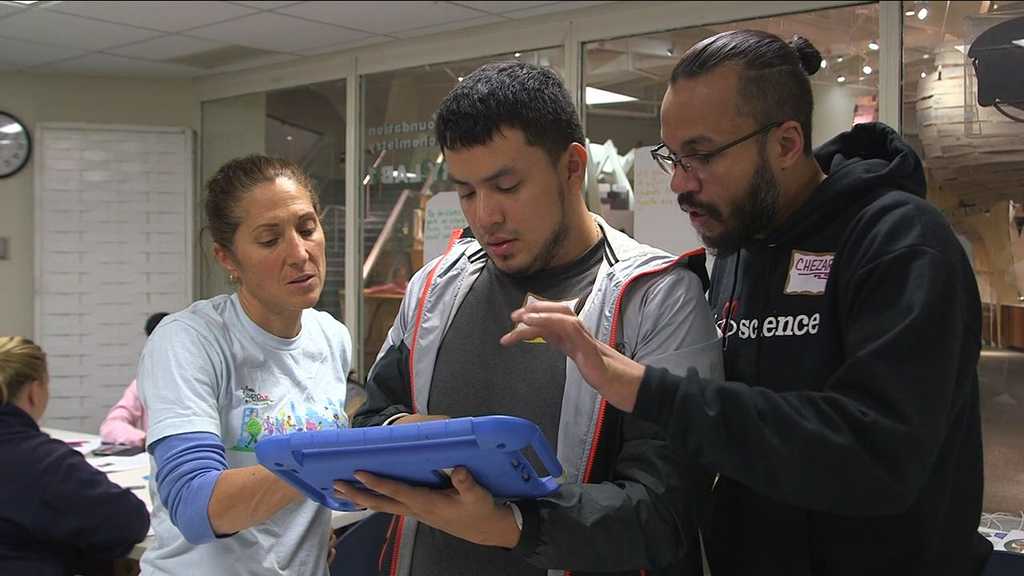
Photo credit: JR Sheetz
As afterschool programs take up the charge of advancing STEM learning for students and pursue curricular bridging as the mechanism for doing so, ExpandED advises providers to be prepared to navigate the inherent tensions between the formal and informal settings and offers the following tips:
- Be prepared to “walk the line” between the more exploratory and youth-driven approach typical of afterschool settings and the content-driven orientation of the school day. Educators must pay close attention to subject-specific content and connections to students’ classroom experiences, while still allowing for youth choice and voice, hallmarks of informal learning. For example, at one school in Manhattan, educators explored the concepts of adaptations and natural selection during a fun Design2Learn session called “Battle Bugs.” Rather than giving vocabulary definitions or examples from natural history as they might in the school day, educators challenged youth to engineer arthropod appendages to “battle” with each other over territory and food (to try the Battle Bugs lesson plan, click here). In this activity, students created a “rubric for success” for their battles (deciding how many items of food they would need to pick up to win), chose real-life arthropods as inspiration for their designs, and engineered a wide variety of appendages—all opportunities for the choice, voice, and ownership of the activity. At the same time, the session allowed youth to explore the advantages and disadvantages of different adaptations and tie the experience to the broader concept of natural selection. Without consistent and deeply thoughtful planning, it is easy for afterschool STEM activities to veer too far in the formal direction, resembling additional hours of traditional school. On the other hand, if programs veer too far in the informal direction, activities often lose the curricular bridge that helps make the day more seamless for students and the learning experiences more robust. In this example, educators struck a wonderful balance: an enticing experience with room for youth choice and authentic connections to grade-level science content.
- Listen to student voices. In a program that uses school-day content and experiences to provide the basis for afterschool programming, students have less control over what science concepts they learn in the afterschool hours. To incorporate choice and voice when students are unable to select the content, prioritize opportunities for students to influence the structure of an activity. In the Battle Bugs activity, youth decided the structure for testing: Each appendage would have to pick up food during testing, and they would compete “tournament-style” so there would be an ultimate showdown between the last surviving appendages. Youth also controlled the definition of “success” for a particular design challenge by determining the number of food items an appendage needed to pick up.
- Be intentional about whether your “curricular bridge” is grounded in content or skills. As New York City further embraces the NGSS, ExpandED has intentionally included both disciplinary core ideas and science and engineering practices as the “curricular bridge” in Design2Learn. However, for some afterschool providers, this type of direct engagement with school-day science content may feel too formal. Afterschool providers can still gain the benefits of curricular bridging by exploring skills and practices in both settings, rather than just content. Program staff, educators, and students can all be explicit about the connections they are making across settings, whether it be content knowledge (such as the characteristics of an arthropod) or practices (such as making an argument from evidence).
Design-based learning
The final core strategy employed in Design2Learn is design-based learning, which incorporates engineering-based, real-world problems that students solve through the development, testing, and redesign of tools and solutions. ExpandED partners with NYSCI to provide 42 hours of professional development trainings annually, as well as two annual on-site support visits to each educator team.
Uniting the engineering design process, NGSS science and engineering practices, and the organization’s own “design-make-play” philosophy, NYSCI trainers taught Design2Learn educators how to facilitate engineering design challenges where students identify a design problem, consider options and constraints, and then plan, model, test, and iterate on solutions. For example, one Design2Learn challenge asked youth to engineer sticky spider webs that mimic the way an ogre-faced spider catches its prey. Using only straws, tape, and yarn, youth created webs that they launched in an attempt to catch their prey (simulated by plastic insects and a Ping-Pong ball). After watching his students engage in the activity, Design2Learn educator Jeffrey Eng commented, “The kids were so engaged … when we did fun activities like this one, they didn’t want to go to their next activities … They said, ‘Nope, I’m finishing!’ They would actually stay from 3:00 p.m. until 5:00 p.m.”
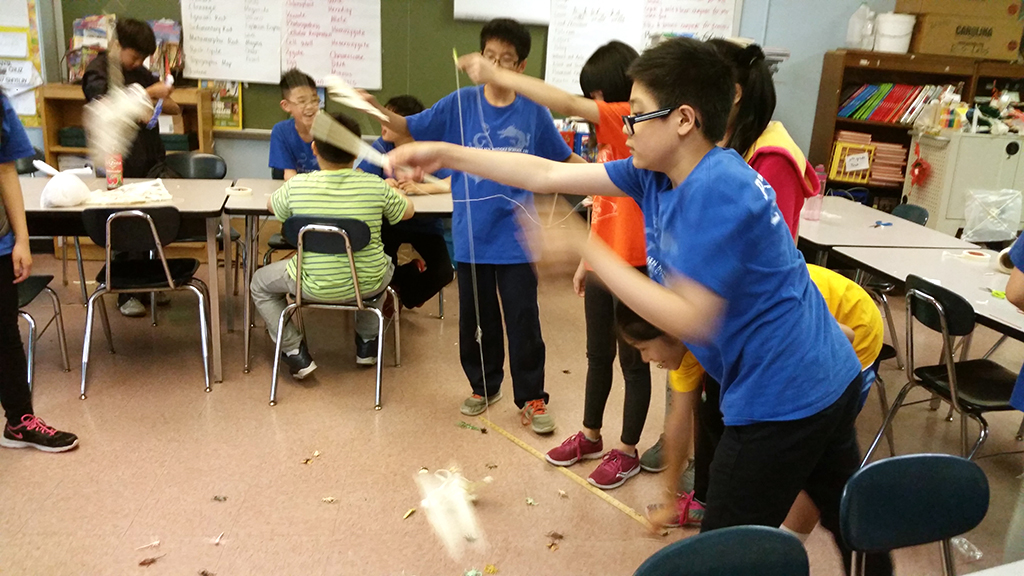
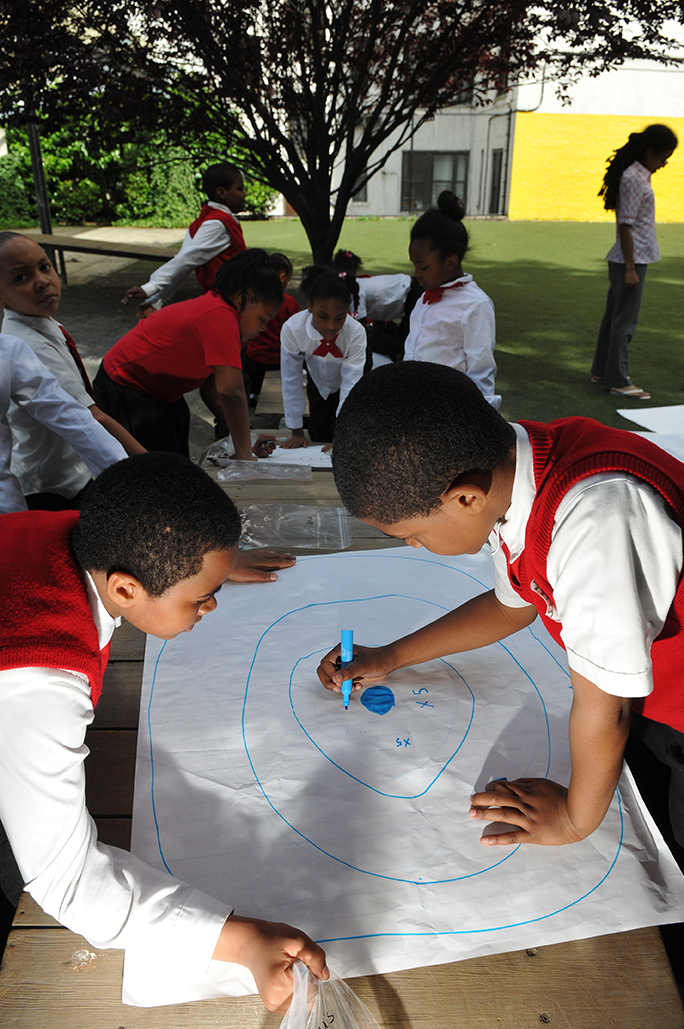
A response like this is not uncommon with design-based activities, which are built to be intrinsically motivating to students by engaging their innate desire to solve problems, create, and learn how things work. Research indicates that children engaged through design-based activities—particularly those who do not believe they are good at science—become more motivated when they witness how core content is integral to solving problems that are personally relevant (Bennett and Monahan 2013). Design-based activities can also help students develop deep conceptual understanding and support the development of the kinds of self-guided inquiry skills that are so critical to success in science (Bennett and Monahan 2013). In support of this theory, activity observations following educators’ participation in the NYSCI professional development series revealed that Design2Learn sites rated higher than nonimplementation sites in a variety of dimensions of program quality, including being hands-on and cognitively challenging, reflecting authentic STEM practices, presenting accurate science content, and being purposefully related to a STEM learning goal (see Resources for additional evaluation data.)
ExpandED Schools has learned that design-based learning, for both certified teacher and community educators, can feel like a whole new way of teaching. For teachers, the focus on students’ progression through the engineering design process and the emphasis on student questioning can be a departure from the lecture-style lessons they employ during the school day. For community educators, the explicit connections to science content; the engineering skills and practices to be taught; and the deep, open-ended questioning for student understanding can feel like overwhelming expectations in comparison to standard afterschool fare. For success in blending these two learning styles, ExpandED suggests the following:
- Be intentional about coaching all educators. Program directors, professional development providers, and intermediary support staff should provide ongoing coaching and feedback to front-line staff and educators on the design-based learning process. In Design2Learn, educators receive on-site instructional coaching and support from ExpandED and NYSCI staff. At least four times a year, a “STEM Coach” from ExpandED or NYSCI observes afterschool sessions to offer in-person, actionable feedback. In addition, ExpandED staff offer supports such as lesson planning, facilitating educator coplanning sessions, modeling instruction, and coleading instruction on an as-needed basis. Design2Learn educators have most often sought guidance on making activities more relevant to students’ lives and interests, incorporating more opportunities for youth choice, and connecting to science content in authentic ways. ExpandED recommends that practitioners be proactive about offering these kinds of support to their own staff to deliver high-quality STEM experiences using a design-based learning approach.
- Offer curricular supports such as lesson plans, assistance in finding activities developed by others (Engineering Everywhere and Design Squad are two popular options), and coaching on effective coplanning strategies so that the onus for developing new engineering design challenges does not fall entirely on educator teams. In the first year of the program, 92% of Design2Learn educators reported that they were spending the bulk of their planning time researching or inventing design-based learning activities from scratch. One afterschool educator at MS 131 in Manhattan reflected, “Activities from Design2Learn [are what we need] so that most of our time isn’t wasted trying to find these ideas or figuring out what we can do next.” To make more space for more substantive discussions, ExpandED now offers lesson plans and other high-quality curricular resources. This shift has not only elevated the quality and consistency of activities from site to site, but it has also given educator teams more time to address topics such as student interest and engagement, coteaching strategies, alignment between the school and afterschool, and STEM facilitation skills. For example, once it had design challenge lesson plans to work from, the educator team at MS 131 decided to focus on including more youth voice in afterschool activities. They spent time discussing strategies they could use, such as asking youth to create the testing criteria for design challenges rather than searching online for lesson ideas.
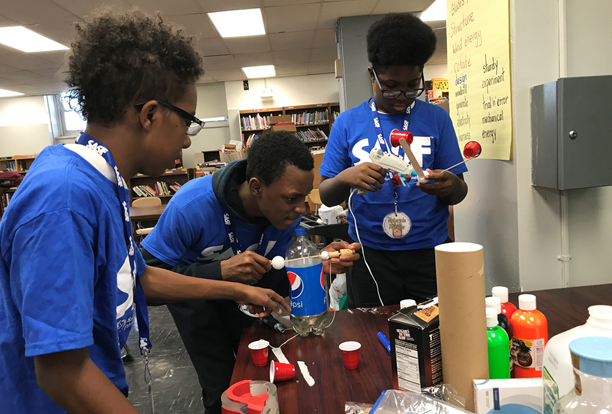
Conclusion
The three strategies central to Design2Learn—collaborative teaching, curricular bridging, and design-based learning—were all established teaching strategies in their own right prior to the program’s founding. What ExpandED Schools has demonstrated through its pilot is that when existing strategies are combined or approached in new ways, a transformational learning experience is possible. However, the keys to this transformation lie in the details of implementation. Curricular bridging and collaborative teaching both hinge on cultivating relationships based in mutual respect and asset-based approaches to problem-solving. Design-based learning works best when educators are able to adapt existing lesson plans and focus their planning time on finding the connections that are going to resonate most strongly with their students. The Design2Learn model works not because it places formal and informal educators in a room together, but because it pays attention to the details of what happens in that room. When those details are held central, educators elevate their practice and students tackle science challenges that appeal to them, contextualize science learning, and provide cohesion between the school day and afterschool.
Lizzie Murchison (lmurchison@expandedschools.org) is senior research associate at ExpandED Schools in New York, New York. Emma Banay (ebanay@expandedschools.org) is the director of STEM programs at ExpandED Schools in New York, New York.
Disabilities Informal Education


